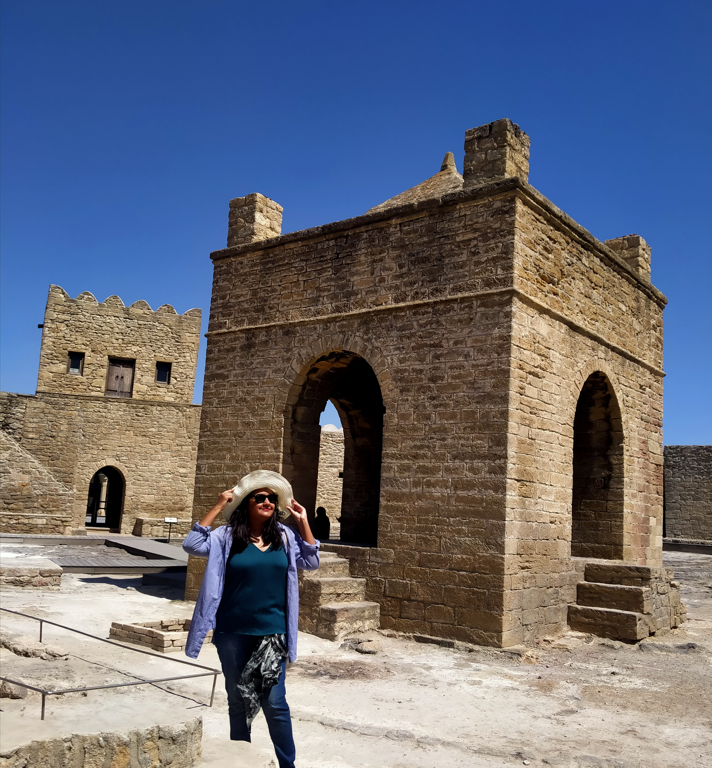By Nivi Shrivastava
“Salam! Welcome to Baku, is it your first time in Azerbaijan?” greeted our curious guide Chinara, a mild-mannered Azeri with bright eyes and thick eyebrows, who had come to receive us at the Heydar Aliyev International Airport with her colleague Leila, a slender light-haired representative from the Tourism Board. Our gracious, 28-year-old something hosts for the next five days, ushered us out and we noticed a fleet of purple and pink London Taxis waiting at the arrivals. The connecting highway dotted with beige-brown homes with slanted rooftops merged with the city’s milieu and led us to the heart of the city gleaming with modern shiny tall buildings reflecting blue skies. Based on our travel, we have drafted a quick guide to some of the most interesting locations here. Here’s how you can plan your travel to this amazing destination and visit these historical places in Azerbaijan.
Home of fire:
Due to its rich sources of oil and subterranean gases, Azerbaijan is popularly known as the land of fire and has multiple references of the same in its historical, political, and cultural context. The iconic landmark and biggest tourist attraction, Flame Towers, are one of the recent symbols of this notion situated in Baku, and across the country, there are other significant ancient monuments built around the concept of burning flames. A popular holy site under UNESCO is Baku Ateshgah aka the Fire Temple of Baku, built like a castle in Surakhany town during the 17th-18th centuries by fire-worshipping Zoroastrians. Pronounced as “Atesh-gahor” meaning the ‘home of fire’ was built atop a now-exhausted natural gas field, which kept the eternal flame burning and became a point of pilgrimage for fire-worshipping Hindus until the end of the 19th century. Among the many compartments inside the shine, one can see the ancient Ganesha statue and inscriptions mentioning Shiva, Ganesha, and Sikh Gurus that indicate the cultural harmony of various religious groups that worshipped here. You can find a nice museum here showcasing how Zoroastrianism evolved in the region along with Hindu and Sikh fire-worshippers.
Natural wonders:
Ahead of the fire temple, in the Absheron District, is the famous Yanardag aka the Burning Mountain, where natural flames from earth jet into the air as far as three metres emerging from a porous sandstone hill. The steady seep of gas from the subsurface keeps the fire burning throughout and one can smell the gas in the atmosphere around this zone. It is claimed that the Yanar Dagh flame was only noted when accidentally lit by a shepherd in the 1950s. Interestingly, there is no seepage of mud or liquid, which distinguishes it from the nearby mud volcanoes of Lokbatan or Gobustan. Apparently, 350 of the 700 volcanoes in the world are in the Azerbaijani Republic and the mud volcanoes of Gobustan are one of the many natural wonders that are spread across the nation. Locals believe the grey lava-rich soil in these mud volcanoes is good for human skin, and one can even take bath in them. However, you will find these in the middle of nowhere in abandoned lands, and jumping into them without a proper guide can prove to be fatal.
An ode to architecture:
The modern city of Baku reflects a perfect combination of influences from the traditional and modern structures, and the city architecture can be divided into 4 parts: Medieval period, Oil Boom, Soviet influence, and Contemporary landmarks. The Old City or the Walled City of Baku with the Shirvanshahs’ Palace and Maiden Tower as inscribed on the UNESCO World Heritage List, describes the medieval aesthetics and preserves the soul of the Shirvanshah dynasty. The palatial complex includes a mosque, mausoleum, hammam, divankhana (reception hall), gates, and reservoir. Today, Baku beams quite exquisite landmarks like the panoramic Highland Park to Heydar Aliyev Centre and the Carpet Museum shaped like a rolled-up rug, welcoming everyone with open arms.
Contrary to the popular notion, Azerbaijan is not an Islamic country but a secular nation and Indian tourists will find a lot to explore here in terms of food and culture. “India is a very important source market for us. We are confident that with the re-launch of direct flights between our capitals, Baku and New Delhi, Indian travellers will be able to enjoy the best of what Azerbaijan can offer from relaxing in nature to visiting architectural landmarks at the heart of the capital city Baku”, mentions Bahruz Asgarov, Deputy CEO of Azerbaijan Tourism Board.
In Baku, one can explore Nizami Street, the largest pedestrian shopping street named after classical Azerbaijani poet Nizami Ganjavi. The street houses famous fashion stores and eateries that are always buzzing with people till late at night. Enjoy the juicy Doner kebabs, dolmas, plov, and piti that are traditional favourites. As you relish the beauty of the city, sip the famous herbaceous Black tea accompanied by sweet Samani halva for a true Azeri experience.
(Trip and experience courtesy: Jazeera Airways and Azerbaijan Tourism)


